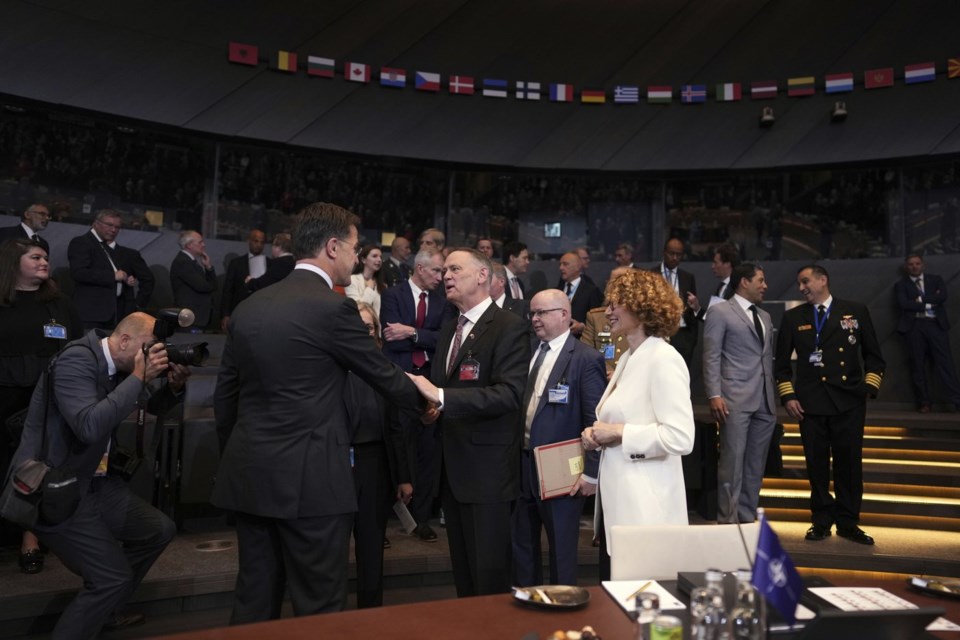OTTAWA — Ottawa is reviewing its spending "from top to bottom" as Canada's closest allies call on Canada to hike defence spending to levels not seen since the height of the Cold War, Defence Minister David McGuinty said Thursday.
McGuinty said the federal government will have more to say "very soon" about its defence spending commitments and will be "making announcements in this regard."
"Canada is revisiting all of its expenditures presently, from top to bottom," he told reporters at NATO headquarters in Brussels.
"We're working very hard now with colleagues to implement a series of changes. We'll have much more to say about that financially in very short order."
McGuinty is in Belgium taking part in the NATO defence ministers’ meeting, the last major NATO meeting ahead of the leaders' summit later this month — where members are expected to agree to a massive hike in their defence spending targets.
Both U.S. Secretary of Defence Pete Hegseth and NATO's Secretary-General Mark Rutte confidently declared the entire alliance is poised to adopt a massive new defence spending commitment — the equivalent of five per cent of GDP — that U.S. President Donald Trump has demanded for months.
“I have total confidence we will get there on the five per cent and we will hammer out some of the details we still have to work on,” Rutte said after Thursday's meeting. “We all know we will be safe for the next couple of years, but then we need to use those years to learn Russian if we don’t do this.”
Hegseth said on the doorstep of NATO headquarters Thursday that he expects all member countries to adopt the new spending target.
“To be an alliance, you’ve got to be more than flags," he said. "We're here to continue the work which President Trump started, a commitment to five per cent across this alliance, which we think will happen — it has to happen — by this summit at The Hague later this month."
Leaders of allied nations are set to gather June 24 and 25 in the Netherlands for the annual NATO summit, but no member country is anywhere close the five per cent benchmark — not even the United States.
Ottawa has long struggled to meet the current two per cent benchmark and spent just 1.33 per cent of its GDP on defence in 2023, according to a recent NATO report. The NATO secretary-general's annual report, released in April, said that Canada's defence spending would hit 1.45 per cent for 2024.
Canada has fallen behind the pack — 22 allies hit the defence spending benchmark in 2024, up from just three in 2014, the report said.
The plan Rutte will put forward at the summit contains some wiggle room to help countries reach that high figure.
It commits member countries to spending 3.5 per cent of annual GDP on core defence needs — such as jets and other weapons — and 1.5 per cent on defence-adjacent areas like infrastructure, cybersecurity and industry.
Canada hasn't spent the equivalent of five per cent of its GDP on defence since 1957, according to data from the Stockholm International Peace Research Institute. The last time it spent two per cent was in 1990.
The government of former prime minister Justin Trudeau suggested that once Canada purchases up to 12 new submarines to replace its aging Victoria class subs, it should meet the two per cent target. But it's not clear how long those purchases would sustain that level of spending.
Ottawa expects to award a contract for the new fleet of subs by 2028.
Prime Minister Mark Carney promised during the recent election campaign to move up Canada's deadline for meeting the two per cent threshold from 2032 to 2030 or sooner.
During their meeting Thursday, NATO defence ministers drew up "capability targets" — shopping lists itemizing the kinds of arms the 32 member nations need to buy, such as air and missile defence systems, artillery, ammunition and drones.
McGuinty said Thursday that Canada is keenly aware of how the global security environment has shifted and is watching geopolitical risks increase.
"We are under no illusions about the scale of the challenges ahead," he said. "Russia's unprovoked and brutal war against Ukraine continues to destabilize the global security landscape. China's growing ambitions and increasingly assertive behaviour are eroding stability in the Indo-Pacific. And the erratic actions of regimes like North Korea and Iran are undermining the rules-based order we all depend on.
"In the face of these growing threats, we must all do more."
— With files from The Associated Press
This report by The Canadian Press was first published June 5, 2025.
Kyle Duggan, The Canadian Press



